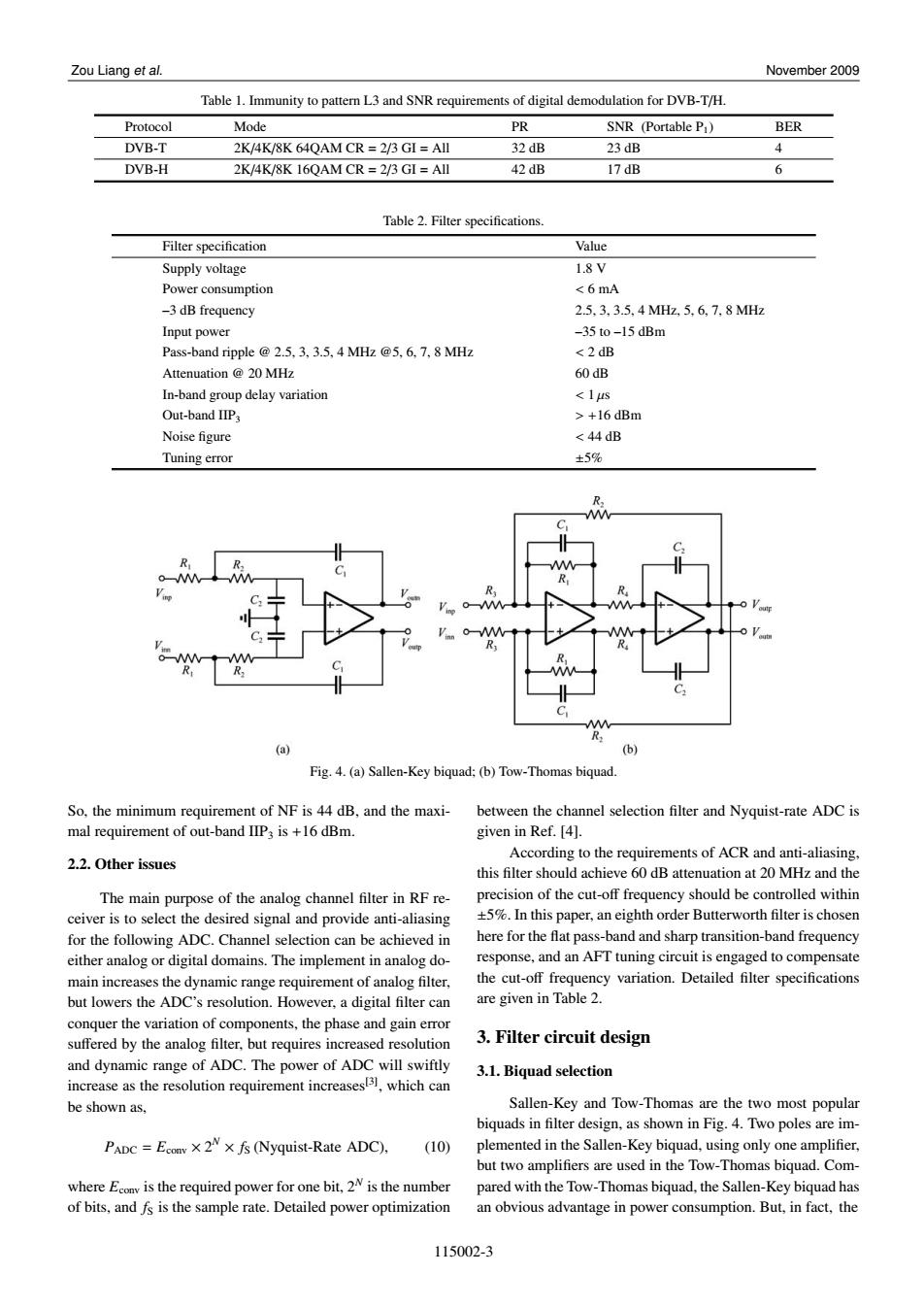正在加载图片...

Zou Liang et al. November 2009 Table 1.Immunity to pattern L3 and SNR requirements of digital demodulation for DVB-T/H Protocol Mode PR SNR (Portable P1) BER DVB-T 2K/4K/8K 64QAM CR=2/3 GI =All 32 dB 23 dB DVB-H 2K/4K/8K 16QAM CR=2/3 GI All 42 dB 17 dB 6 Table 2.Filter specifications Filter specification Value Supply voltage 1.8V Power consumption <6mA -3 dB frequency 2.5.3.3.5.4MHz.5.6,7.8MHz Input power -35 to -15 dBm Pass-band ripple 2.5.3,3.5,4 MHz @5,6,7,8 MHz <2 dB Attenuation 20 MHz 60 dB In-band group delay variation <1s Out-band IIP3 >+16 dBm Noise figure <44dB Tuning error ±5% M R o-W R C C nAAy (a) (b) Fig.4.(a)Sallen-Key biquad;(b)Tow-Thomas biquad. So,the minimum requirement of NF is 44 dB,and the maxi- between the channel selection filter and Nyquist-rate ADC is mal requirement of out-band IIP;is +16 dBm. given in Ref.[4]. 2.2.Other issues According to the requirements of ACR and anti-aliasing. this filter should achieve 60 dB attenuation at 20 MHz and the The main purpose of the analog channel filter in RF re- precision of the cut-off frequency should be controlled within ceiver is to select the desired signal and provide anti-aliasing +5%.In this paper,an eighth order Butterworth filter is chosen for the following ADC.Channel selection can be achieved in here for the flat pass-band and sharp transition-band frequency either analog or digital domains.The implement in analog do- response,and an AFT tuning circuit is engaged to compensate main increases the dynamic range requirement of analog filter, the cut-off frequency variation.Detailed filter specifications but lowers the ADC's resolution.However.a digital filter can are given in Table 2. conquer the variation of components,the phase and gain error suffered by the analog filter,but requires increased resolution 3.Filter circuit design and dynamic range of ADC.The power of ADC will swiftly 3.1.Biquad selection increase as the resolution requirement increases31,which can be shown as. Sallen-Key and Tow-Thomas are the two most popular biquads in filter design,as shown in Fig.4.Two poles are im- PADC Ecomv x 2N x fs(Nyquist-Rate ADC), (10) plemented in the Sallen-Key biquad,using only one amplifier, but two amplifiers are used in the Tow-Thomas biquad.Com- where Econv is the required power for one bit,2N is the number pared with the Tow-Thomas biquad,the Sallen-Key biquad has of bits,and fs is the sample rate.Detailed power optimization an obvious advantage in power consumption.But,in fact,the 115002-3Zou Liang et al. November 2009 Table 1. Immunity to pattern L3 and SNR requirements of digital demodulation for DVB-T/H. Protocol Mode PR SNR (Portable P1) BER DVB-T 2K/4K/8K 64QAM CR = 2/3 GI = All 32 dB 23 dB 4 DVB-H 2K/4K/8K 16QAM CR = 2/3 GI = All 42 dB 17 dB 6 Table 2. Filter specifications. Filter specification Value Supply voltage 1.8 V Power consumption < 6 mA –3 dB frequency 2.5, 3, 3.5, 4 MHz, 5, 6, 7, 8 MHz Input power –35 to –15 dBm Pass-band ripple @ 2.5, 3, 3.5, 4 MHz @5, 6, 7, 8 MHz < 2 dB Attenuation @ 20 MHz 60 dB In-band group delay variation < 1 µs Out-band IIP3 > +16 dBm Noise figure < 44 dB Tuning error ±5% Fig. 4. (a) Sallen-Key biquad; (b) Tow-Thomas biquad. So, the minimum requirement of NF is 44 dB, and the maximal requirement of out-band IIP3 is +16 dBm. 2.2. Other issues The main purpose of the analog channel filter in RF receiver is to select the desired signal and provide anti-aliasing for the following ADC. Channel selection can be achieved in either analog or digital domains. The implement in analog domain increases the dynamic range requirement of analog filter, but lowers the ADC’s resolution. However, a digital filter can conquer the variation of components, the phase and gain error suffered by the analog filter, but requires increased resolution and dynamic range of ADC. The power of ADC will swiftly increase as the resolution requirement increases[3], which can be shown as, PADC = Econv × 2 N × fS (Nyquist-Rate ADC), (10) where Econv is the required power for one bit, 2N is the number of bits, and fS is the sample rate. Detailed power optimization between the channel selection filter and Nyquist-rate ADC is given in Ref. [4]. According to the requirements of ACR and anti-aliasing, this filter should achieve 60 dB attenuation at 20 MHz and the precision of the cut-off frequency should be controlled within ±5%. In this paper, an eighth order Butterworth filter is chosen here for the flat pass-band and sharp transition-band frequency response, and an AFT tuning circuit is engaged to compensate the cut-off frequency variation. Detailed filter specifications are given in Table 2. 3. Filter circuit design 3.1. Biquad selection Sallen-Key and Tow-Thomas are the two most popular biquads in filter design, as shown in Fig. 4. Two poles are implemented in the Sallen-Key biquad, using only one amplifier, but two amplifiers are used in the Tow-Thomas biquad. Compared with the Tow-Thomas biquad, the Sallen-Key biquad has an obvious advantage in power consumption. But, in fact, the 115002-3